You grew up knowing how to point your finger and set your sights on things you want - it's a natural experience. But pointing a firearm and learning which part of your sights to focus on requires direction.
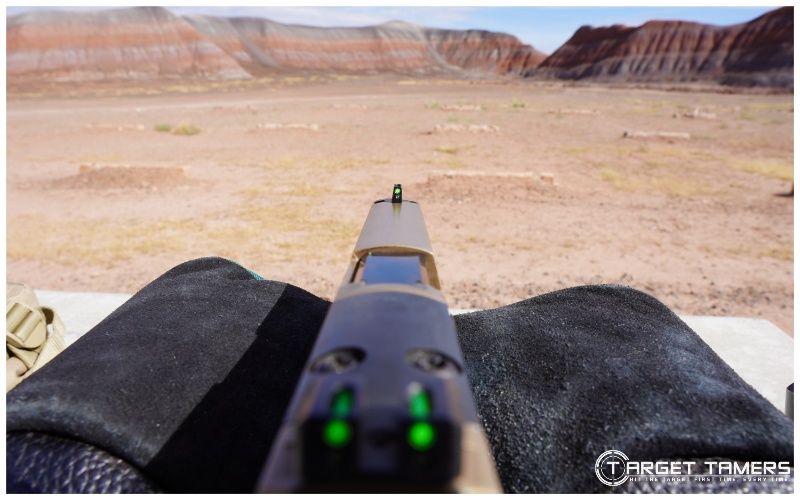
Understanding how to aim with iron sights requires knowledge of sight alignment, sight picture, zeroing, and more. While iron sights are different in type from one model to the next and between pistol and rifle sights, the goal is shared: put aligned sights on the target and shoot.
I cover how to get your POA (Point of Aim) to match your POI (Point of Impact) in this guide. From sight post alignment to front sight focusing and a discussion on aimed vs pointed shooting, many facets of aiming your iron sights are explored.
How to Aim Iron Sights – BUIS VS Pistol Sights
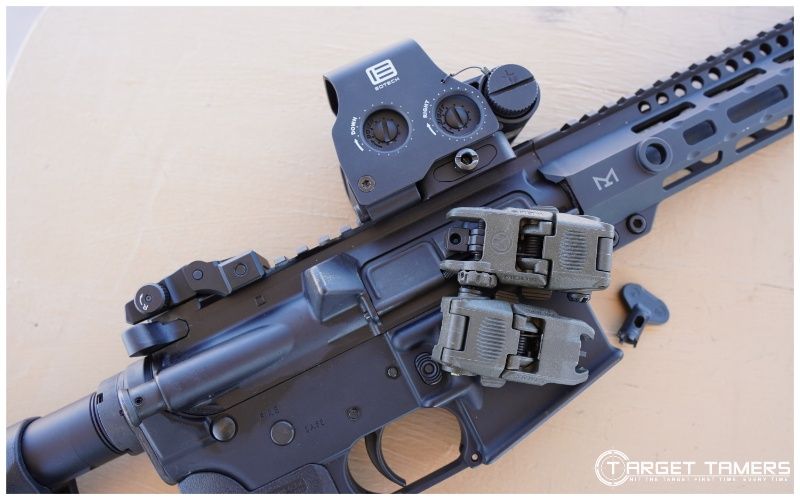
In general, there are a lot of factors that contribute to iron sight accuracy whether they’re on a pistol or rifle. Though red dot sights are extremely popular, iron sights are tremendously durable, do not require a power source, are excellent for close range, and are affordable.
Pistol sights look very different to rifle sights, and there are variations within each type too. However, the principle of using either type of sighting system remains the same. You must acquire:
- Sight alignment
- Sight picture
- Front sight focus
- Practice good shooting fundamentals
I’ll discuss each topic here to provide an in-depth look at each part of the aiming process with iron sights.
Rifle Sights VS Pistol Sights
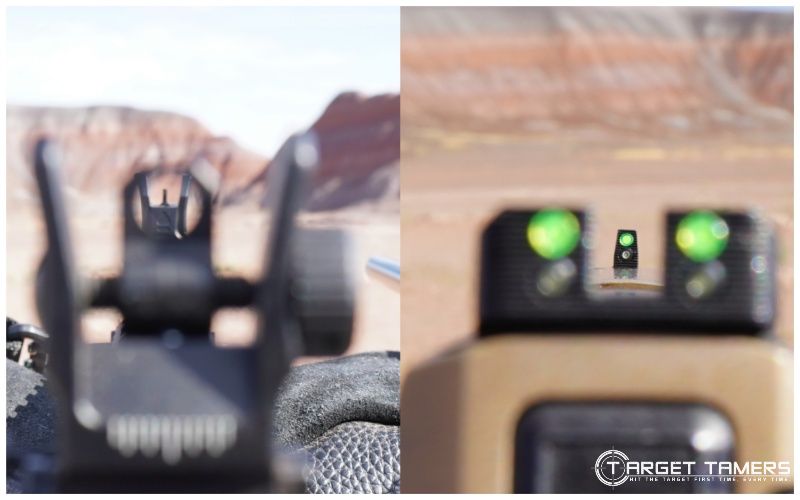
On average, pistol sights are smaller, come in several variations, and can be more difficult to adjust than rifle sights. Rifle sights also vary with fixed front sights and adjustable rear sights to adjustable combos like BUIS systems for an AR-15.
What does it look like through some of the most common iron sights?
Below, you can see what it looks like with tritium pistol sights in low light conditions, fiber optic rifle sights on a muzzleloader, and back-up irons sights (BUIS) on an AR-15.
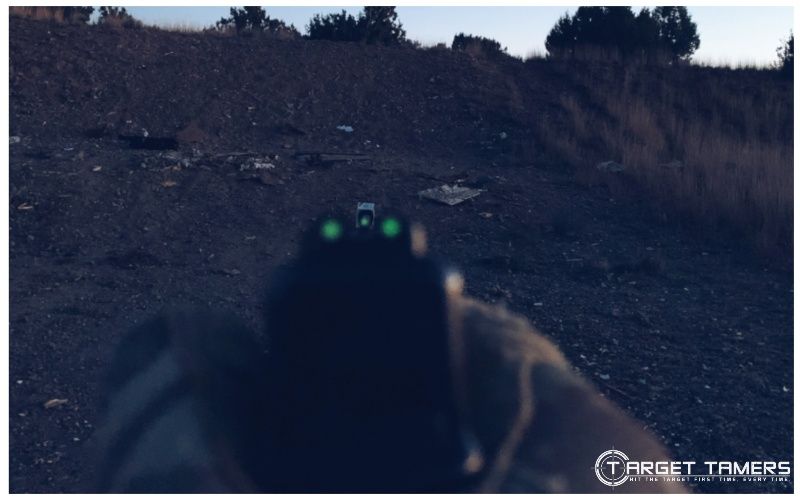
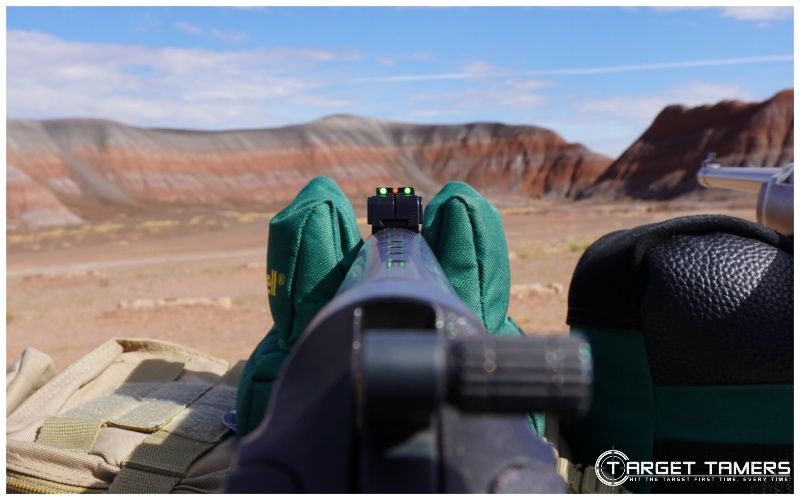
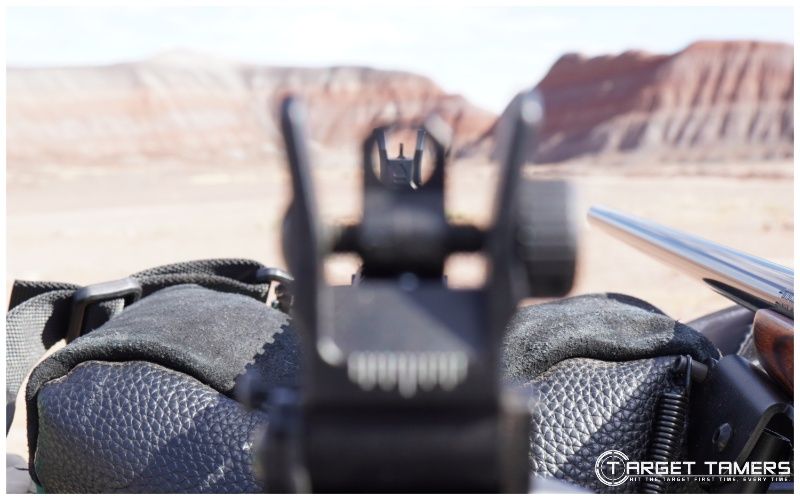
Each view is different but the principle of ‘put the front sight on the target’ remains the same between all of them.
For more information on types of iron sights, check out our Iron Sights Beginner’s Guide.
Sight Alignment
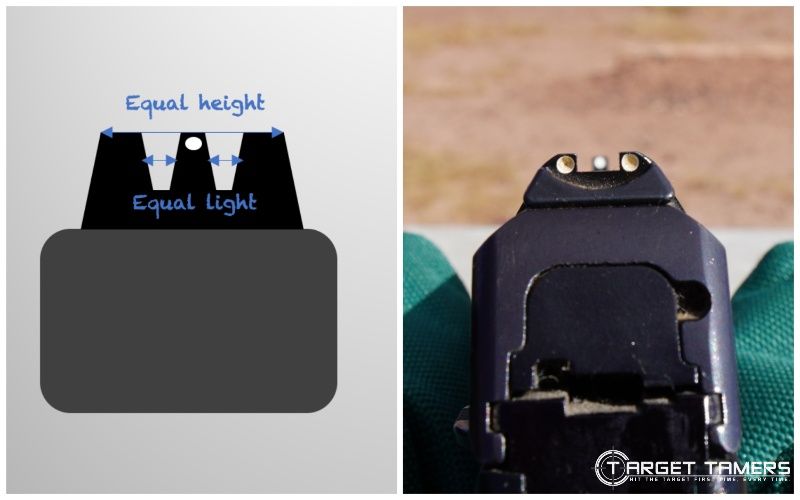
Sight alignment is the relationship between the eye and the iron sights – front and rear sights. An easy way to remember proper sight alignment is equal height and equal light. The front sight should be spaced between the notch or through the peep at center and at equal height of the rear peep sight.
Equal height means the top of the front sight and the top of the rear sight should be on the same horizontal plane.
Equal light means the gap created between the front sight and the notch or the peep should be equal on both sides.
Both these alignments must be acquired simultaneously if accuracy is desired.
Tips:
- Dots on pistol sights don’t always represent the POA (Point of Aim) and/or POI (Point of Impact) for the firearm. Learn what the hold is for your firearm and ignore the dots if applicable.
- Practice firearm presentation to get familiar and intimate with what proper sight alignment looks like. Doing this against a blank background, like a wall, will help with front sight focus, sight alignment familiarity, and firearm indexing.
- We explain what sight alignment is and more here!
Sight Picture
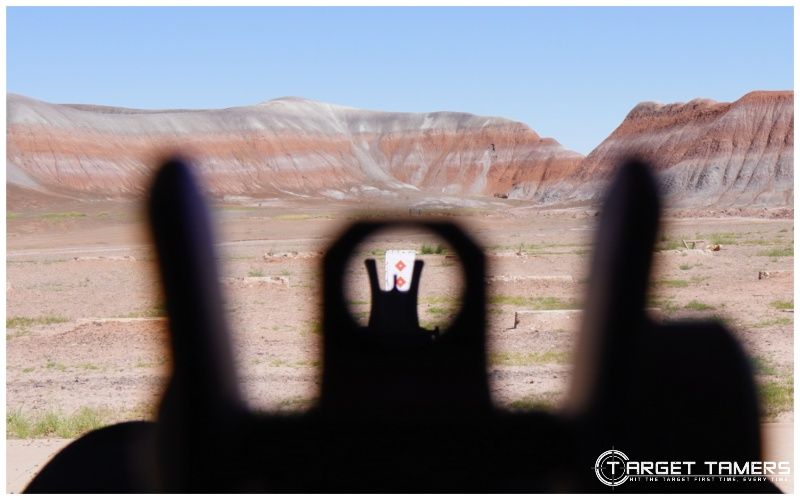
The sight picture is the relationship between your eyes, sights, and target. The aligned sights are now projected onto the target and lined up for a POA. Whether you’re using pistol sights or running BUIS, focus on the front sight. This creates a slightly blurry target and ghosted rear sight.
How one uses their sights to aim at a target is often described by a sight picture method. Though there are a few types, the most common are the combat and center holds.
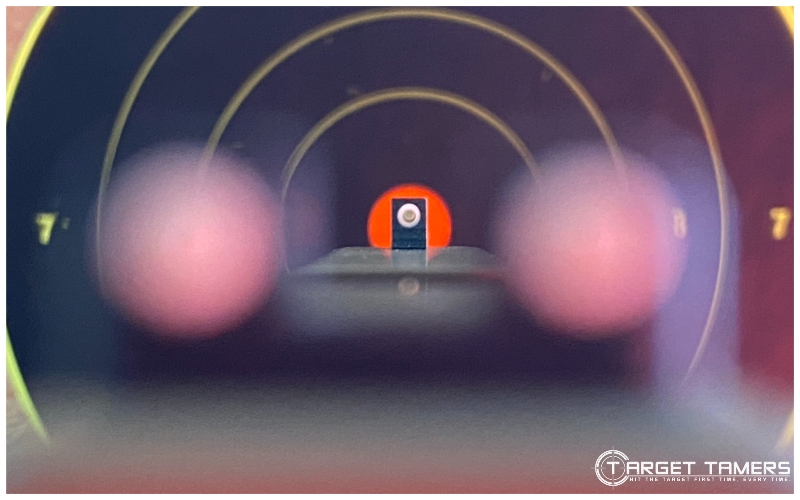
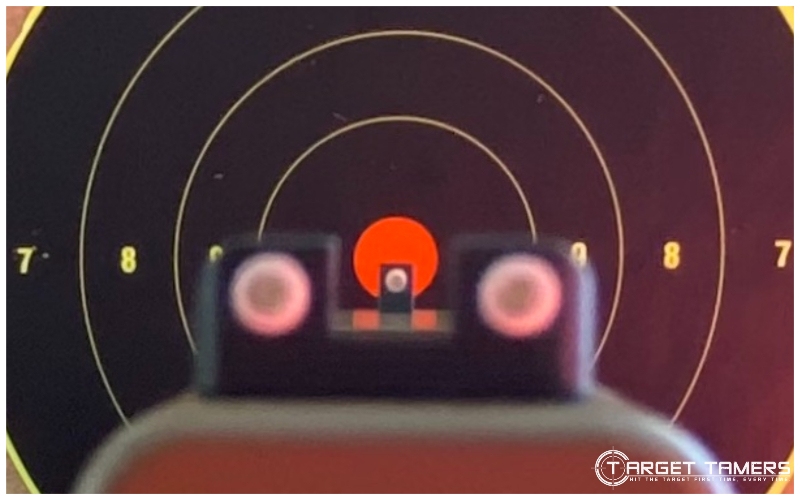
The combat hold requires the front sight to completely cover the POA. The POI is the same as the POA and is covered by the front sight – whether there is a dot or not.
The POA and POI for the center hold is the very top edge of the front sight.
To understand more about this, see our What is the Sight Picture guide!
How to Zero Iron Sights
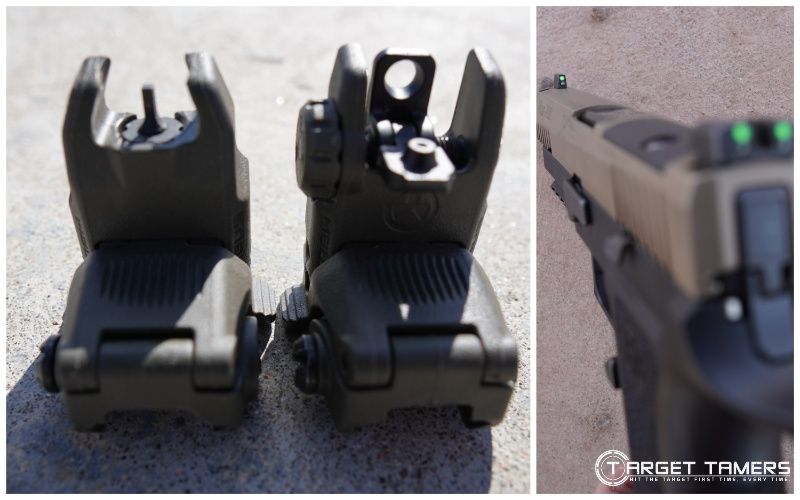
Overall, zeroing iron sights is a culmination of acquiring sight alignment, sight picture, and sight adjustments. Correctly aiming sights has everything to do with a sighted-in aiming system, and this is true of iron sights and optical sights.
Pistols sights have a rule to follow: FORS. Front Opposite. Rear Same. The front post is adjusted up and the POI comes down. The front post is adjusted down, and the POI goes up. The rear sight moves left, the POI moves left. The rear sight moves right, the POI moves right.
For BUIS systems, like AR-15 MBUS sights, they rotate for adjustments creating clicks. Typically, clockwise rotations make up adjustments on the front sight and right adjustments on the rear sight. Counterclockwise rotations make down adjustments on the front sight and left adjustments on the rear sight.
If you can always acquire sight alignment and a good sight picture, you’ll almost always hit your target where you intended.
To learn how to zero iron sights, we have a step-by-step instructional guide!
Front Sight Focus
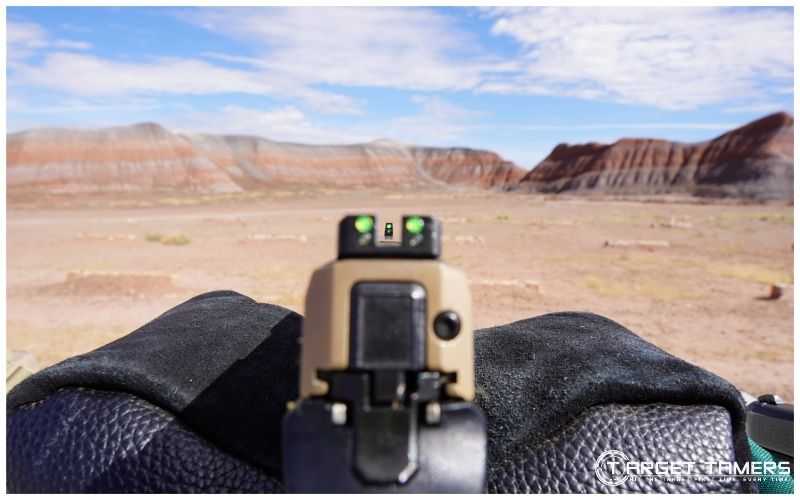
Whether shooting with open pistol sights or aperture sights on an AR-15, there are three focal planes that are fighting for attention: the rear sight, front sight, and the target. The focus is on the front sight that causes the rear sight to ghost out and the target to become slightly blurry.
Why should you put your focus on the front sight?
Tip:
For precision shots, focusing on the front sight can ensure you have sight alignment when you obtain the sight picture. Small deviations in the placement of that front sight will affect accuracy downrange.
There will always be some unsteadiness because of breathing, balance, etc. It makes for good breathing and trigger control practice. Short of using a sled and sitting at the bench with a rest, the largest variable in shooting with irons is you – the shooter.
This also includes those with aging eyes who can’t see the front sight clearly or those with bi or trifocal glasses where you need to contort your head to use the sights.
But there is an argument for target focused shooting without irons or an optical sight i.e. red dots. Point shooting requires what I would call intuitive shooting skills where you use a lot of physiological systems to aid the visual system in shooting fast and accurately.
Aimed Shooting VS Point Shooting
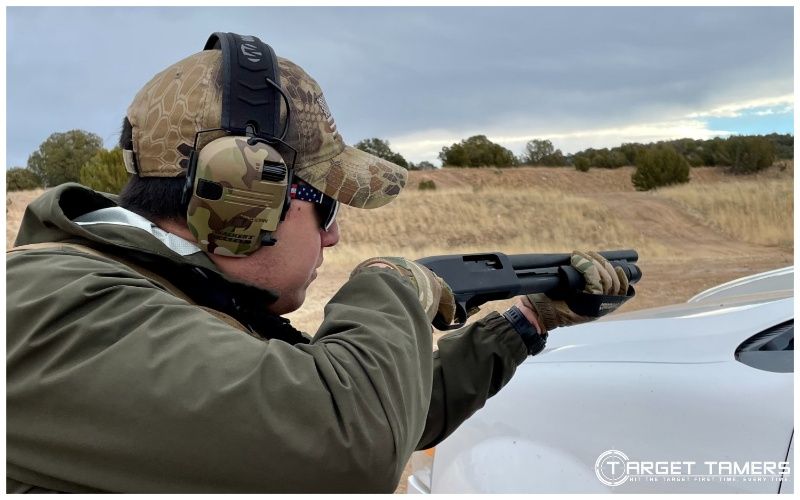
The Quick Fire method was used by the US Army with the definition for aimed shooting as sighted shooting. Pointed shooting was target engagement without sights using instinct and peripheral vision to acquire muzzle-target alignment.
The point of defining aimed shooting and point shooting is to make clear that there’s a time and place for various techniques and methods.
Though focus on front sight has been the hard and fast rule for a long time, I would be remiss in not mentioning that target focus shooting is also a well-known technique. Think Wyatt Earp or modern-day gunslinger Bob Munden.
Aimed shooting with iron sights benefits:
Pros:
- Visual aiming system
- Greater accuracy
- Can be learned
- More forgiving of bad shooting fundamental habits
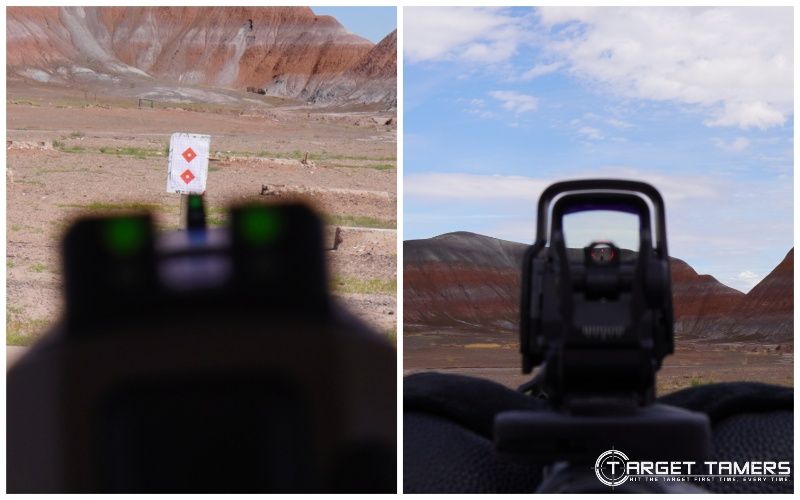
Cons:
The downside is that you must take your eyes off the target. In a combat scenario, stress might interfere with being able to focus on seeing the front sight clearly. Additionally, between acquiring sight alignment and sight picture, time is lost in what could be critical moments where breaking a shot is more important.
Point shooting benefits:
Pros:
- Can be faster
- Target focused
- Easier to see target than front sight for old eyes
- Great for moving targets
- Appropriate for CQB (3-21 feet)
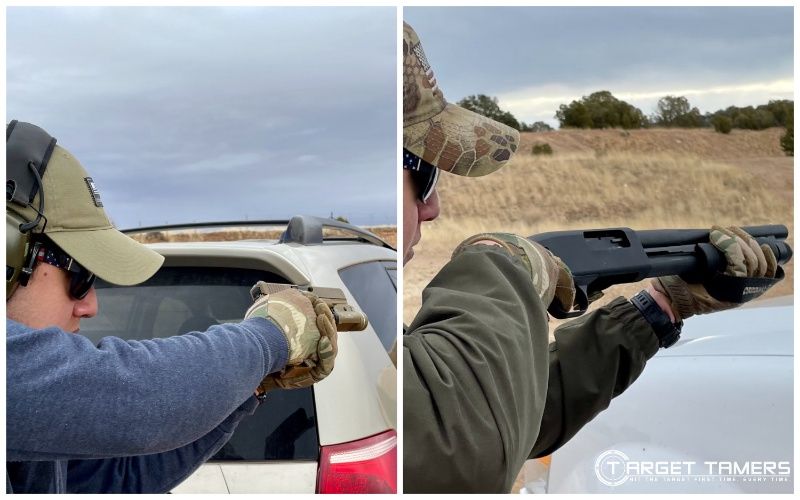
Cons:
The downside is that inconsistency and bad habits greatly affect point shooting accuracy. It requires a lot of practice and rounds to master, and it can be difficult to transition between aimed and point shooting in combat engagements.
Perhaps it’s time to think about using both these skills for appropriate applications. It could mean a combination of both for competition shooting or pointed shooting for CQB and aimed shooting for 21 feet and greater distances in defensive shooting.
Shooting at the bench and when you’re in a combat/defensive engagement are very different applications, and I would say it’s a matter of necessity and application that governs which method is best to use.
On that note, pistol and AR-15 red dot sights have really changed the dynamics of field engagement. With a red dot, you are always target focused and they’re faster to use than iron sights. See our Iron Sights VS Red Dot comparison guide for more.
Shooting Fundamentals
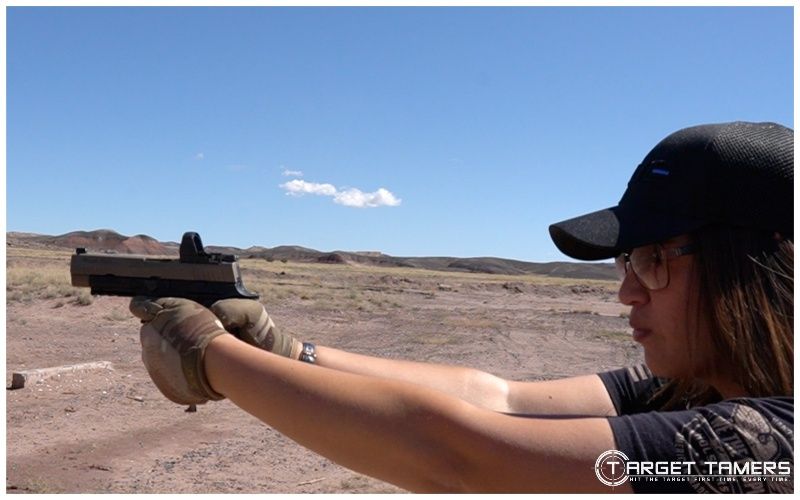
There is much to be learned when it comes to both pistol and rifle shooting. Far from just using a sighting system, it also requires stance, grip, presentation, trigger control, breathing, follow through, and recovery. To become a proficient shooter, these shooting fundamentals must be understood.
I’ll briefly discuss each one as they all apply to aiming with sights, getting on target, improving accuracy, and ensuring the safety of all those involved.
Stance/Position
From prone to standing and awkward positions, how you stand will impact the initial shot and ones that follow. It can affect speed and accuracy. Weight forward, balance, firearm in front, and hold it with confidence.
Grip
Grip varies from one person to the next. It’s appropriate to learn about grip whether you’re shooting handguns or rifles. It’s how you’ll manage recoil, hold steady, and improve accuracy. Shooting hand high up against the beaver tail/backstrap (pistol) or pistol grip (rifle), thumbs forward, hands meeting with no gap.
Presentation
From holster to line of vision (pistol) or from strap, vehicle, or closet to line of vision (rifle), the presentation of your firearm is about getting it up and your irons within your vision. Practice, practice, practice makes this a skill that comes smoothly.
Trigger Control
You can have great sight alignment, sight picture, stance, and a good grip but if you don’t know your trigger, that discharge can be surprising, or the POI is far from where it was supposed to be. A good trigger position is between the crease and the tip of the finger. Dry firing is a good practice to get familiar with the trigger and managing it. Always follow safe dry firing practices – no ammo around!
Breathing
Between your lungs, heart, balance, and stance, holding stationary is impossible. Fortunately, you don’t need to be absolutely static to make a good shot. Oxygen is important for all parts of the aiming and shooting process. It’s common practice to take the shot on the exhale either halfway through the breath or at the tail end.
Follow Through
Probably the hardest fundamental to learn is follow through. It’s easy to understand why it’s difficult because it requires you to maintain all the fundamentals even after the round has left the barrel. Follow through recoil, keep with the sights, maintain breath and trigger control, hold that grip – it’s all needed for timed comps, hunting, combat and self-defense shooting, etc.
Recovery
When you don’t have a range safety officer or instructor at your back as a constant reminder, it’s easy to lose focus and forget safety protocols. From shooting position back to an empty chamber back to the holster, rack, or the case, situational awareness is always required. Safety protocols must be practiced regardless of if you’re alone or with friends or a working team.
FAQ's
Iron sight adjustment abilities vary. Many pistol sights are fixed and can't be adjusted without a special tool such as a sight pusher. Some rear sights allow for both elevation and windage adjustments. Most BUIS sights will have a front sight to adjust for elevation and the rear sight for windage.
For an in-depth how-to on adjusting pistol or AR-15 iron sights, zero in on our How to Zero Iron Sights guide.
Adjustable elevation sight (left) & fully adjustable elevation and windage rear sight (right) - Image by Tina Fa'apoi (Own Work) for Target Tamers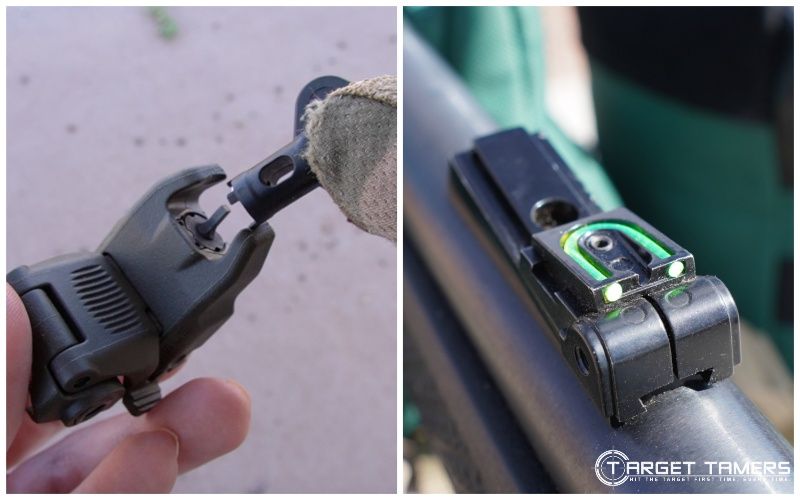
On average, the best advice is to learn to shoot with two eyes open. This increases a shooter’s field of vision, spatial orientation for balance, and more light in the eyes in lowlight conditions. Practicing with two eyes open can improve self-awareness, threat assessment, and reaction time.
In general, there are hunts that do not allow scopes. This leaves open sights as the aiming system. Hunting with iron sights is a long-done practice and game is often taken inside 150 yards. Though riflescopes are generally preferred, hunting with sights can be fast, easy, and convenient to employ.
Muzzleloader (left) iron sights have taken down many an elk & Ruger 10/22 with sights is used for small game (right) - Image by Tina Fa'apoi (Own Work) for Target Tamers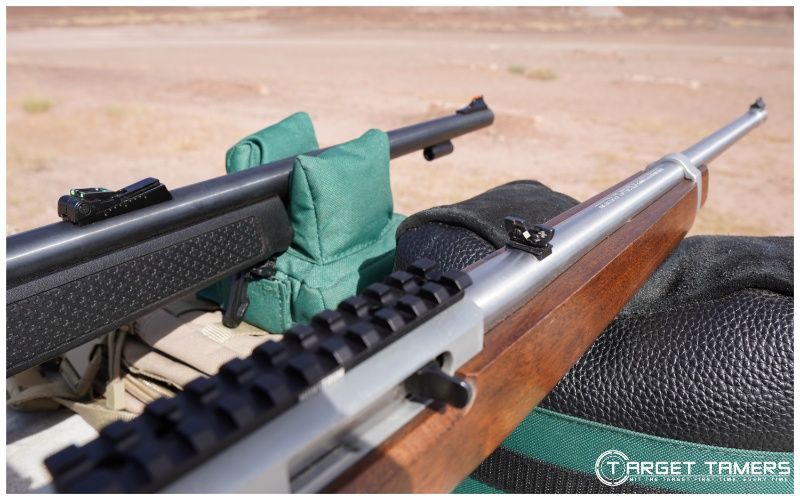
Overall, one of the most common pistol zeros is 25 yards with a pistol red dot sight. Indoor pistol ranges usually have 25-yard lanes to accommodate this. For concealed carry firearms with iron sights, a 10 or 15-yard zero is considered sufficient.
The preference for either red dot sights or iron sights is largely a matter of personal bias. Iron sights are durable, have a long history of use, and are generally cheaper than red dots. However, red dot sights are extremely easy to use, can be affordable, and can go to distance.
Our comparison guide answers Red Dot VS Iron Sight questions from features to applications.
Image by Tina Fa'apoi (Own Work) for Target Tamers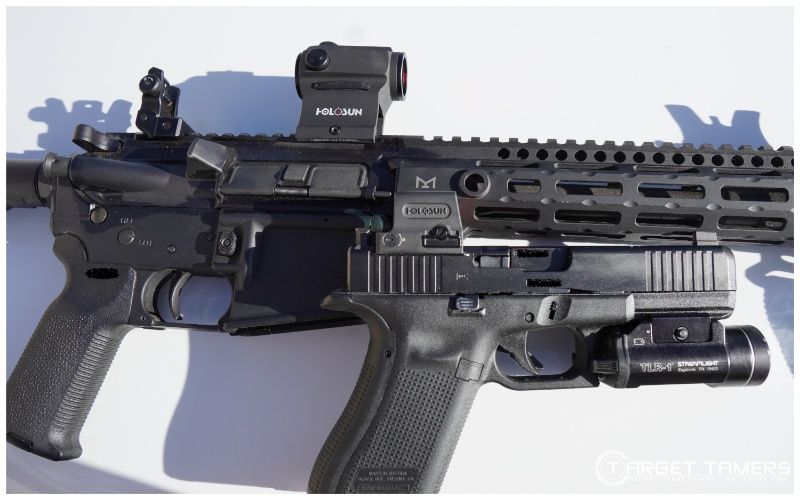
Running Irons? Know How to Use Them!
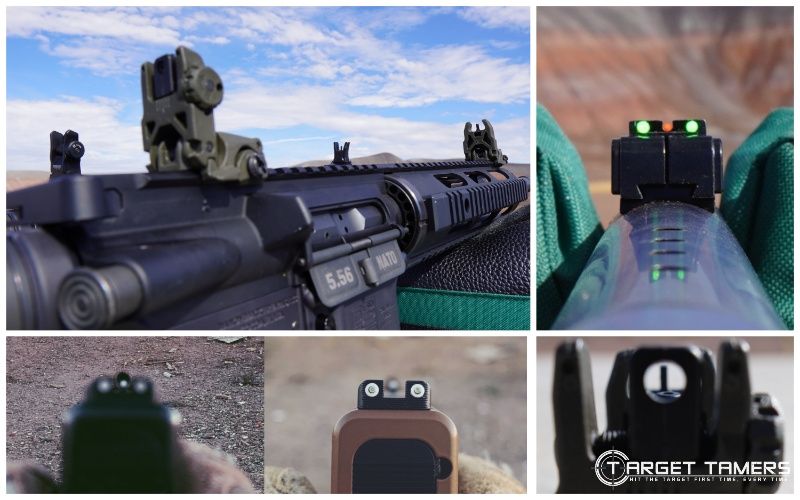
Once upon a time, irons were the primary sighting system. Currently, many civilians are running irons as a back-up in case of red dot or scope failure or just for looks. To them I ask, do you still know how to aim iron sights?
When you’re responsible for every round that comes out of that muzzle whether it’s for recreational shooting, home defense, or a profession, it’s your job to know where that round is going to go. If your POI is not where it’s meant to be, you need to refresh yourself on aiming with irons.
Further Reading



